
Edge computing can reduce the computing load on your data center infrastructure by moving data and computation to the edge. However, such devices complicate your organization’s IT systems because staff must learn to deploy, protect, and maintain the devices. Consider various software management options for edge devices.
As the management of edge computing devices becomes increasingly difficult for IT professionals, many organizations are looking to software applications and platforms to manage the assets, data, and power of edge devices.
Some edge device management tools Data center infrastructure management tool, And cloud or Internet of Things (IoT) management tools have other edge management capabilities. Data center professionals have so many tools available that you should consider the specific features of the tool and your business budget before deciding which tool is best for your organization.
Edge computing management function
Edge computing has many implications for IT professionals, but for data center administrators it usually means centralizing the computing infrastructure in an orderly, sustainable and limited way. Centrally manage the edge environment Don’t touch A seamless interface between the environment and existing methods and processes.
The key management features that need to be considered for edge computing needs are:
- Integration into existing monitoring software tools. Network monitoring and management software should be easy Integrate edge devices.. Make sure that you can provision, deploy, and manage devices in your existing software environment, or that you have access to new applications for them.
- Communication and bandwidth monitoring. Most powerful computing is done in the data center, but edge computing shifts some of its power to the edge. This can increase bandwidth usage in both directions and across the network. Make sure your network is ready to handle this.
- Latency monitoring. Edge computing monitoring software needs to detect changes in latency in real time. For some devices, it may be important to understand which devices require low latency and which devices can handle higher latency.
- Power monitoring. Power monitoring of edge devices is especially important for devices that are remote or inaccessible.
- Data storage. Edge devices need to store only the data needed for their functionality and should not store any more. Organizations need to create processes that move data from edge devices or provide processes for those devices to calculate or use that data to reduce the load. As you move that data, it becomes available to large processing systems elsewhere in your network, and you can use it to gather additional insights.
- Security. Due to its network capabilities, your organization should include: Edge devices in all security strategies Beforehand. Hackers can target devices that store high-value data, so you need to plan to protect them.
- automation. Edge devices or edge monitoring software should include automation features that help IT staff perform monitoring and maintenance activities. For example, an automated process can move data from a device to a central database on a regular basis, provision resources on the device, or register the device.
- Backup and disaster recovery. Make sure that the current disaster recovery and backup process considers edge devices in your network. Ignoring these devices can lead to significant financial and legal losses.
AWS IoT service
Some software applications help organizations manage their edge devices better. AWS offers a set of IoT software options to help organizations build, deploy, manage, and protect edge devices. AWS edge device management products include:
- Green grassSoftware that runs on edge devices and enables local processing, messaging, data management, and secure network connectivity.
- Communication software that connects devices to the network without IoT Core, external servers or other network devices.
- IoT Device Defender, a standalone security monitoring software for securely connecting and protecting edge devices.
- IoT Device Management is a full-service IoT device monitoring software application that registers, organizes, monitors, and remotely manages edge devices.
You can check the pricing page for each application or contact the vendor for pricing information.
EdgeX Foundry
Another edge device management platform is EdgeX Foundry. EdgeX Foundry acts as a two-way conversion engine between edge devices and business applications, whether they are in the data center or in the cloud. Foundry provides one major service related to edge device management called the Systems Management Agent.
The system management agent acts as the main communication hub between various edge devices and data centers, enabling two-way communication between the system and management for requests such as status checks, performance metric requests, service start or stop requests, etc. ToIn essence, it facilitates the larger management system that the network may have.
EdgeX Foundry is open source, so you can download and use it for free.
FNT command
FNT Command is a modular system that enables you to manage, control, protect, and support infrastructure assets across multiple environments and configurations. FNT Command for IT Management helps optimize device interactions throughout the network. FNTCommandfor Networks, Connectivity & Communication Services integrates network-wide management activities and information. It collects information about devices and resources and provides resource analysis to help you analyze and optimize your resources.
FNT offers a variety of pricing options for your organization, including purchases, licenses, leases, and SaaS arrangements.
"device" - Google News
June 13, 2021 at 02:34PM
https://ift.tt/3wjiRtO
Evaluate edge computing software for device management - Illinoisnewstoday.com
"device" - Google News
https://ift.tt/2KSbrrl
https://ift.tt/2YsSbsy
Bagikan Berita Ini















0 Response to "Evaluate edge computing software for device management - Illinoisnewstoday.com"
Post a Comment